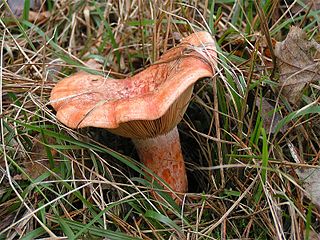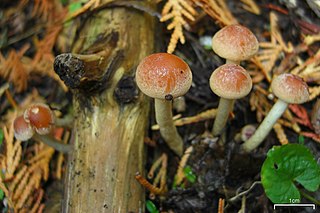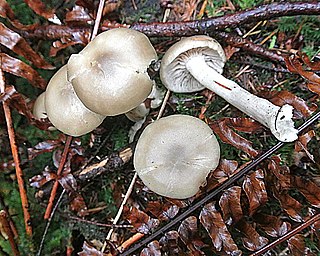
Hypholoma lateritium, sometimes called brick cap, chestnut mushroom, cinnamon cap, brick top, red woodlover, or kuritake is rarer and less well-known than its relatives, the inedible, and poisonous sulfur tuft and the edible Hypholoma capnoides. Its fruiting bodies are generally larger than either of these. Hypholoma sublateritium is a synonym.

Lactarius deliciosus, commonly known as the saffron milk cap and red Despite mushroom, is one of the best known members of the large milk-cap genus Lactarius in the order Russulales. It is found in Europe and has been accidentally introduced to other countries under conifers.

Amanita citrina, commonly known as the false death cap or citron amanita, is a basidiomycotic mushroom, one of many in the genus Amanita. It grows in silicate soil in the summer and autumn months. It bears a pale yellow or sometimes white cap, with white stem, ring and volva. Though not deadly, it is inedible and often confused for the lethal death cap.

Gymnopilus sapineus, commonly known as scaly rustgill, is a small and widely distributed mushroom which grows in dense clusters on dead conifer wood. It has a rusty orange spore print and a bitter taste. This species does not stain blue and lacks the hallucinogen psilocybin.

Hydnellum caeruleum is an inedible fungus found in North America, Europe, and temperate areas of Asia. It is commonly known as the blue-green hydnellum, blue spine, or blue tooth.

Albatrellus is a genus of 19 species of mushroom-producing fungi in the family Albatrellaceae. Species are common in northern temperate forests, producing medium to large fleshy fruit bodies of various colors.

Albatrellus subrubescens is a species of polypore fungus in the family Albatrellaceae. The fruit bodies (mushrooms) of the fungus have whitish to pale buff-colored caps that can reach up to 14.5 cm (5.7 in) in diameter, and stems up to 7 cm (2.8 in) long and 2 cm (0.8 in) thick. On the underside of the caps are tiny light yellow to pale greenish-yellow pores, the site of spore production. When the fruit bodies are fresh, the cap and pores stain yellow where exposed, handled, or bruised.

Hydnellum aurantiacum is an inedible fungus, commonly known as the orange spine or orange Hydnellum for its reddish orange or rusty red colored fruit bodies. Like other tooth fungi, it bears a layer of spines rather than gills on the underside of the cap. Due to substantial declines in sightings, this species is listed as critically endangered in the United Kingdom.

Baeospora myosura, commonly known as conifer-cone baeospora, is a species of fungus that produces mushrooms with long, coarse hairs. It grows on plant material and manure. It is white to cream and the spore color is white, cream, or yellowish. It is commonly found in North America and Europe. The common name of the mushroom is conifercone cap. It was described in 1938 by mycologist Rolf Singer. It is regarded as nonpoisonous.

Agaricus semotus is a woodland mushroom of the fungus order Agaricales. It, like many of its relatives, can be found spread throughout wooded, moist areas in the southern United States, and has been found in areas ranging from California to Florida; it is also indigenous to Great Britain and Europe. A. semotus has also been collected in New Zealand. Although various authors disagree about its edibility, its modest size prevents it from being a significant source of nutrition.

Gymnopilus bellulus is a species of mushroom in the family Cortinariaceae. It was given its current name by American mycologist Murrill in 1917. It is odorless, bitter in taste, and regarded as inedible.

Albatrellus ovinus is a terrestrial polypore fungus found in western North America, and Northern Europe. It is very closely related to the rarer A. subrubescens, from which it may be distinguished microscopically by the amyloid spore wall. It is edible and sold commercially in Finland.

Tricholoma saponaceum, also known as the soap-scented toadstool, soapy knight or soap tricholoma is an inedible mushroom found in woodlands in Europe and North America.

Xeromphalina campanella is a species of mushroom. The common names of the species include the golden trumpet and the bell Omphalina. The genus name Xeromphalina means "little dry navel" and campanella means "bell-shaped", respectively describing the mature and young shapes of the pileus, or cap. The mushroom is also called fuzzy-foot.

Lactarius affinis, commonly known as the kindred milk cap, is a species of milk-cap mushroom in the family Russulaceae. It is found northeastern North America, where it fruits in the summer and fall, and is common in the Great Lakes region. Its fruit bodies have medium to large, slimy dull yellow or brownish caps. Although not considered poisonous, it is unpalatable because of its highly acrid taste.

Coprinopsis picacea is a species of fungus in the family Psathyrellaceae. It is commonly called magpie inkcap fungus. It was first described in 1785 by French mycologist Jean Baptiste François Pierre Bulliard in 1785 as Agaricus picaceus.

Bolbitius titubans, also known as Bolbitius vitellinus, is a widespread species of mushroom found in America and Europe. It grows chiefly on dung or heavily fertilized soil, and sometimes on grass. It is nonpoisonous.

Lentinellus montanus is a species of agaric fungus in the family Auriscalpiaceae. It is found at high elevations in the Pacific Northwest region of North America, where it fruits singly or in clumps on decaying conifer wood.

Pholiota astragalina is a species of fungus in the family Strophariaceae. It was first described scientifically in 1821 by Elias Magnus Fries as a species of Agaricus. Rolf Singer transferred it to the genus Pholiota in 1951. The fruitbodies of the fungus have pinkish-orange caps measuring 2–5.5 cm in diameter. The flesh is orange, blackening in age, with a bitter taste. They produce a reddish-brown spore print, causing it to be placed in its genus rather than Hypholoma, which it resembles. The spores are oval to elliptical, smooth with thin walls, and measure 5–7 by 4–4.5 µm. In North America, the fungus is found in the United States and Canada. In Europe, it has been recorded from France, Sweden, and Switzerland. Its mushrooms usually grow singly or in small clusters, sometimes on conifer logs.

Entoloma sericellum is a species of mushroom-forming fungus belonging to the family Entolomataceae. It appears in conifer and hardwood forests.



















